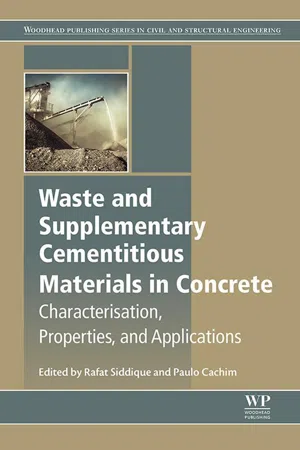
Waste and Supplementary Cementitious Materials in Concrete
Characterisation, Properties and Applications
- 640 pages
- English
- ePUB (mobile friendly)
- Available on iOS & Android
Waste and Supplementary Cementitious Materials in Concrete
Characterisation, Properties and Applications
About this book
Waste and Supplementary Cementitious Materials in Concrete: Characterisation, Properties and Applications provides a state-of-the-art review of the effective and efficient use of these materials in construction. Chapters focus on a specific type of material, addressing their characterization, strength, durability and structural applications. Sections include discussions of the properties of materials, including their physical, chemical and characterization, their strength and durability, modern engineering applications, case studies, the state of codes and standards of implementation, cost considerations, and the role of materials in green and sustainable construction. The book concludes with a discussion of research needs.- Focuses on material properties and applications (as well as 'sustainability' aspects) of cementitious materials- Assembles leading researchers from diverse areas of study- Ideas for use as a 'one stop' reference for advanced postgraduate courses focusing on sustainable construction materials
Frequently asked questions
- Essential is ideal for learners and professionals who enjoy exploring a wide range of subjects. Access the Essential Library with 800,000+ trusted titles and best-sellers across business, personal growth, and the humanities. Includes unlimited reading time and Standard Read Aloud voice.
- Complete: Perfect for advanced learners and researchers needing full, unrestricted access. Unlock 1.4M+ books across hundreds of subjects, including academic and specialized titles. The Complete Plan also includes advanced features like Premium Read Aloud and Research Assistant.
Please note we cannot support devices running on iOS 13 and Android 7 or earlier. Learn more about using the app.
Information
Coal bottom ash
Abstract
Keywords
1.0 Introduction
1.1 Uses of CBA
1.1.1 Construction of road base and subbase
Table of contents
- Cover image
- Title page
- Table of Contents
- Copyright
- List of contributors
- Preface
- Part I: Waste materials
- Part II: Supplementary cementitious materials
- Index